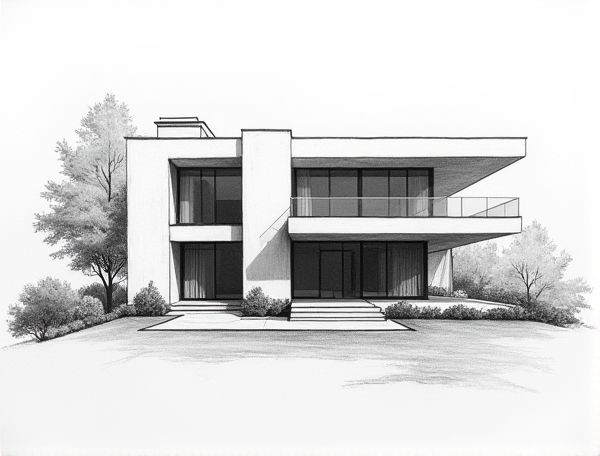
Photo illustration: Bauhaus home design with ribbon window façade
Bauhaus home design emphasizes clean lines and functionality, with ribbon window facades creating uninterrupted bands of glass that maximize natural light and enhance the minimalist aesthetic. Explore how incorporating these sleek windows can transform your living space by reading more in the article.
Introduction to Bauhaus Home Design
Bauhaus home design emphasizes simplicity, functionality, and the integration of art with technology, originating from the German Bauhaus school founded in 1919. Characterized by clean lines, flat roofs, and open floor plans, it eliminates unnecessary ornamentation to create practical living spaces. Key materials include steel, glass, and concrete, promoting minimalism and a strong connection between form and function.
Defining the Ribbon Window Façade
The Ribbon Window Facade features long horizontal bands of windows that enhance natural light penetration while maintaining a sleek and modern aesthetic. This design element promotes continuous views and a strong connection between interior spaces and the outdoor environment. Ribbon windows are commonly used in minimalist architectural styles to emphasize horizontal lines and create a sense of openness.
Historical Origins of the Ribbon Window
Ribbon windows originated in the early 20th century with Modernist architects such as Le Corbusier, who popularized their use in the International Style of architecture. These horizontal bands of windows allowed for increased natural light and panoramic views, breaking away from traditional segmented window designs. Their introduction marked a shift towards functionalism and a minimalist aesthetic in home design, emphasizing clean lines and open, airy interiors.
Core Principles of Bauhaus Architecture
Bauhaus architecture embraces functional design, emphasizing clean lines, geometric shapes, and the harmony of form and function to create efficient living spaces. It integrates modern materials like steel, glass, and concrete with open floor plans and minimal ornamentation, fostering simplicity and practicality in home design.
Key Features of Bauhaus Homes
Bauhaus homes emphasize functional design with clean lines, flat roofs, and large windows to maximize natural light, creating an open and airy atmosphere. Your space benefits from minimalist interiors, integrated built-in furniture, and a seamless connection between indoor and outdoor areas, enhancing both aesthetics and practicality.
Functional Aesthetics: The Ribbon Window in Practice
The Ribbon Window enhances your living space by seamlessly combining sleek, horizontal design with expansive natural light, promoting both aesthetic appeal and energy efficiency. This architectural feature not only maximizes outdoor views but also supports ventilation, improving comfort and functionality in modern home designs.
Material Choices for Façade and Windows
Selecting durable, weather-resistant materials such as fiber cement panels, natural stone, or high-quality brick enhances the longevity and aesthetic appeal of facades. Energy-efficient window options like double or triple glazing, low-E coatings, and thermally broken frames improve insulation while reducing energy costs. Integrating sustainable materials like reclaimed wood or aluminum with powder coating supports eco-friendly home design without compromising functionality.
Benefits of Ribbon Windows in Modern Living
Ribbon windows maximize natural light and provide uninterrupted panoramic views, enhancing both the aesthetic appeal and energy efficiency of modern homes. Their sleek, horizontal design improves ventilation and creates a seamless connection between indoor and outdoor spaces, elevating overall living comfort.
Notable Examples of Bauhaus Ribbon Window Homes
Notable examples of Bauhaus ribbon window homes include the iconic Haus am Horn in Weimar, Germany, featuring continuous horizontal windows that maximize natural light and facilitate seamless indoor-outdoor connections. The Gropius House in Massachusetts exemplifies this design with its long, banded windows that emphasize simplicity and functional aesthetics, hallmark traits of Bauhaus architecture.
Tips for Incorporating Ribbon Windows in Contemporary Design
Ribbon windows enhance contemporary design by creating continuous horizontal bands of natural light that emphasize sleek lines and open spaces. To maximize their impact, position them strategically along exterior walls for panoramic views while ensuring proper insulation and shading to maintain energy efficiency and comfort.
 homedesy.com
homedesy.com